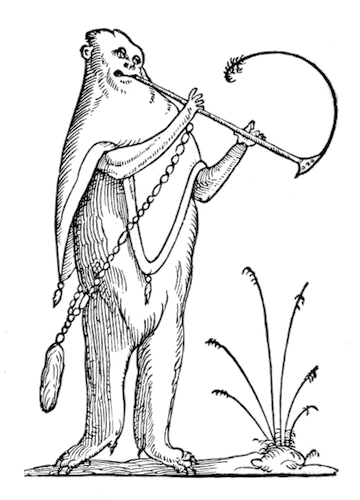
Cannibal Modernity: Oswald de Andrade’s Manifesto Antropófago (1928)
 Scroll through the whole page to download all images before printing.
Scroll through the whole page to download all images before printing.Oswald de Andrade, “Manifesto Antropófago”, Revista da Antropofagia (1928) — Source.
 Scroll through the whole page to download all images before printing.
Scroll through the whole page to download all images before printing.Oswald de Andrade, “Manifesto Antropófago", Revista da Antropofagia (1928) — Source.
In April 1924, a small party of Brazilian artists and writers set out into the forests and hills that lay beyond their home city of São Paulo to discover a country they hardly knew — their own. This group included the poet Oswald de Andrade and the painter Tarsila do Amaral, his soon-to-be wife; the future novelist Mário de Andrade (no relation), and their wealthy older friends: Paulo da Silva Prado, a coffee planter and art patron, and Dona Olívia Guedes Penteado, the daughter of another coffee baron, who was the sponsor of the group’s artistic exploits. They were joined on the excursion by the French poet Blaise Cendrars, on his first visit to Brazil, whom they had collected off his ship and whisked away to the Carnival festivities in Rio de Janeiro a couple of months earlier.
In truth, it was no intrepid explorers’ mission. The local climate was amenable and the country prosperous, once from gold, now from coffee. The journey was undertaken in some comfort. The towns and plantations they visited in the states of São Paulo and Minas Gerais were of a kind more or less familiar to them. But their brief immersion in the countryside was enough to spark inspiration. They returned to the city with specimens, sketches and, from their limited contact with the Indigenous people, a new vocabulary of Tupi words to describe the flora and fauna. From this was to emerge a new and enriched idea of what modern Brazilian culture should be.
The major consequence of this excursion was a manifesto that was to prove explosive for modern art in Brazil and beyond. All artistic declarations of intent have to begin boldly, and this one, the “Manifesto Antropófago”, or “Cannibalist Manifesto” — which appeared illustrated by Tarsila do Amaral in the artistic group’s house journal, Revista da Antropofagia, in 1928 — did not disappoint: “Cannibalism alone unites us. Socially. Economically. Philosophically.”
Portrait of Oswald de Andrade from an unknown year — Source.
We will come back to the cannibalism. Other clauses of the Manifesto were more in tune with modernist aspirations the world over, prizing the new over the conventional, and calling for a progressive revolution: “Down with all the importers of canned consciousness”; “Down with Memory as a source of custom. The renewal of personal experience.” One tradition that could be kept was Carnival, with its celebration of masquerade and misrule, and inversion of authority, where the Indigenous might suddenly appear the master of the European. The enemy was the legacy of colonial rule and the dominant culture of Europe more generally: “Down with the histories of Man that begin at Cape Finisterre.” The Anthropophagists rejected the imposed norms that were a hangover from Portuguese rule — its language, its science, its laws and land seizures: “Lazy is the mapamundi of Brazil.”
Naturally, the most widely quoted clause in the Manifesto was the one that appeared in English: “Tupi, or not tupi that is the question.” This irreverent line — glib perhaps, but irresistible once thought of — sums up the artistic program by showing as well as telling us how cultural cannibalism might operate.
To underscore the reassertion of Indigenous cultural right, Oswald de Andrade signed the Manifesto and dated it: ”374 Years since of the Swallowing of Bishop Sardinha”, a reference to the first bishop of Brazil, who was killed and eaten by members of the Caeté tribe of Tupi people when the ship he was ready to sail home in was wrecked at the mouth of the São Francisco River in 1556.
Perhaps a more revealing aspect of the Manifesto was the claim that: “Before the Portuguese discovered Brazil, Brazil had discovered happiness.” This statement conferred a local imprimatur on a vision that applied, and perhaps still applies, in Europe and North America of far-off Brazil as a kind of natural and human paradise, a place not only abundant, tropical, and permissive, but also one where race has become unimportant — a fantasy, of course, but one worth holding on to. In the same year as Oswald’s Manifesto, 1928, Mário de Andrade published a novel, Macunaíma, which also took inspiration from the group’s expedition. It is a riotous origin myth for his country that rivals Virginia Woolf’s Orlando, published a few months later, in its games with gender fluidity, and adds its own episodes of racial slippage for good measure, presenting an ideal of a multiracial Brazil where the Indigenous population, those of African heritage descended from enslaved people, and those with colonial European blood might be equivalent. Mário’s narrative also played to the notion of Brazil as a once-and-future Arcadia, even if its vision of racial harmony was naive at best, and at worst, self-serving and colonial in its own way, given that two of these three groups were historically alien to the country.
But, so far as creating art went, this inclusiveness was the point. Inspiration was to be found not only among Indigenous sources, which would be entirely new to the outside world, but also taken from the European, the African, and indeed anyone at all. This was the cannibalism Oswald de Andrade had in mind. Here, he was informed by what he had learnt about Indigenous practices of anthropophagy, where the consumption of human flesh was not indiscriminate or driven by mere hunger, but strictly ritualized and subject to rules of selectivity. Thus, only certain people were eaten — “Absorption of the sacred enemy”, as Andrade put it — and only certain parts of their bodies were consumed, in order to complete the identity of the victorious consumer. Andrade’s translation of these practices into the world of artistic creation was both an attempt to lift the moral opprobrium applied to Indigenous people by the colonizer and to construct a full identity for Brazilian culture.
Illustration accompanying Oswald de Andrade, “Manifesto Antropófago", Revista da Antropofagia (1928) — Source.
Lest this all still seem to be in unnecessarily poor taste, some points of contemporary context:
One. “Bad artists borrow; great ones steal.” It wouldn’t be in the right spirit to worry about who said it — the statement has been attributed variously to Picasso, Stravinsky, and T. S. Eliot. The point is that the idea of cultural theft was in the air, especially among modernists. Oswald de Andrade: “I am only concerned with what is not mine. Law of Man. Law of the cannibal.”
Two. The Manifesto expectedly name-checks Freud (Totem and Taboo) and William James (The Varieties of Religious Experience), but also Serge Voronoff, the briefly celebrated surgeon who transplanted monkey testicles into his rich clients with the promise that it would slow the ageing process, gently suggesting that old Europe was not without its own cannibalistic tendencies.
Three. Why shouldn’t Brazilians eat Western art, when foreign empires were consuming their very land? 1928 saw the foundation of Fordlândia, Henry Ford’s worker town in the former forests of Pará state, which he had cleared to plant rubber trees to make tires for American cars.
How does the Manifesto antropófago stand up today? Brazilian critics are divided. Some believe that Andrade and his troupe played a bad hand; they were already too Europeanized themselves for their message to strike home. The “Tupi or not tupi” quote was an unfortunate own goal, merely revealing their indebtedness to the Western canon. The cannibalizing process had been jogging along quite happily for centuries without the need for any pretentious cultural theory. As for that voyage into the Brazilian heart of darkness: “That this episode continues to be transmitted, unironically, as a ‘discovery’ attests to the endurance of social structures that allow Brazilian elites to live out their lives with little experience of the majority culture in their own country”, according to the art historian Rafael Cardoso, writing in 2021.
For others, however, the sentiments expressed in the Manifesto retain their potency nearly a hundred years on, both as a jesting provocation amid pious current arguments about cultural appropriation, and perhaps, too, as a comment on the recent orgy of political and environmental autophagy in Brazil itself. They were repurposed in the 1960s by the Tropicália movement in music in response to a military coup in the country, and references to anthropophagy continue to pop up in the titles of artistic events into this century, too, offering a reconsideration or reapplication of the ideas of the 1920s modernists. Now, however, in a further iteration of the original conception, we find the anthropophagy theme more often driven by Indigenous creators, with the Andrades as the ones being metaphorically eaten. The feasting goes on.
With thanks to Julia Martins and Ben Miller.
Enjoyed this piece? We need your help to keep publishing.
The PDR is a non-profit project kept alive by reader donations – no ads, no paywalls, just the generosity of our community. It’s a really exciting model, but we need your help to keep it thriving. Visit our support page to become a Friend and receive our themed postcard packs. Or give a one-off donation. Already a supporter? A huge thank you for making all this possible.
Jul 31, 2025







